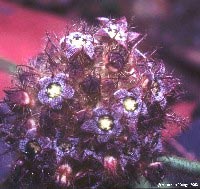Life Sciences and Chemistry
Articles and reports from the Life Sciences and chemistry area deal with applied and basic research into modern biology, chemistry and human medicine.
Valuable information can be found on a range of life sciences fields including bacteriology, biochemistry, bionics, bioinformatics, biophysics, biotechnology, genetics, geobotany, human biology, marine biology, microbiology, molecular biology, cellular biology, zoology, bioinorganic chemistry, microchemistry and environmental chemistry.

Curator Finds, Names New Species of Climbing Milkweed
A new species of climbing milkweed has been named by Alexander Krings, curator of the North Carolina State University Herbarium (also NCSC, its international Index Herbariorum abbreviation). The species – Gonolobus tenuisepalus Krings – was first collected in the tropical rainforests of southern Costa Rica while Krings was a graduate student in the Department of Forestry.
“The flowers are tiny (about 6-8 millimeters in diameter), purplish to dark brownish-red and borne in

NC State Chemist Creates Structure in Amorphous Materials
A chemist at North Carolina State University has made breakthrough discoveries that advance basic understandings of the nature of liquids and glasses at the atomic and molecular levels. Featured in the Sept. 26 issue of Nature, these discoveries could lead to the development of totally new materials with useful optical and electronic properties – as well as applications not yet foreseen.
Liquids and glass have long been understood by scientists to be amorphous, meaning “without structure.”

NIAMS Scientists Find Biochemical "Switch" Directs Muscle Building
Scientists may soon be able to influence muscle formation more easily as a result of research conducted in the National Institute of Arthritis and Musculoskeletal and Skin Diseases’ Laboratory of Muscle Biology. The researchers there and at institutions in California and Italy have found that inhibitors of the enzyme deacetylase can switch the pathway of muscle precursor cells (myoblasts) from simply reproducing themselves to becoming mature cells that form muscle fibers (myotubules).
It has

Newly revealed viral structure suggests a continuum in the evolution of viruses
An international team of scientists led by researchers at The Wistar Institute has combined two different imaging techniques to uncover the molecular-level framework of a common bacteriophage, a virus that infects bacteria. The results, reported in the October issue of Nature Structural Biology, suggest that viruses developed a continuum of progressively more complex architectural strategies to cope with their increasing size as they evolved. An image from the study is featured on the journal’s

Gene found that helps nerve cells survive by preventing cell suicide
Finding may lead to new treatments for neurologic disease and nerve injury
Why do some nerve cells survive and regrow after injury while others shrink away and die? A new discovery by researchers at Massachusetts General Hospital (MGH) shows that the expression of a particular gene may be responsible for protecting neurons from death. The results, published in the September 26 issue of Neuron, could lead the way for new treatment strategies for a variety of neurological diseases.

Biologist’s new experiment may vindicate Darwin
Charles Darwin, the founder of the modern theory of evolution, was an avid proponent of sympatric speciation, the idea that a single species need not be geographically divided in order to evolve into two separate species. In the mid-20th century, however, certain vocal scientists convinced the scientific community that geographically isolating two halves of a population was a necessary factor in creating a new species. It wasn’t until the last few decades that modern biologists began to reexamine Da